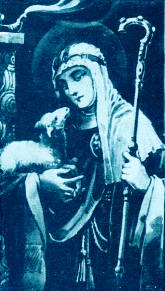Lives of the Saints
Our Models and Protectors
Spiritual Bouquet:
February 1st

Saint Bridgid
Abbess and Patroness of Ireland
(436-523)
Next to the glorious Saint Patrick, Saint Bridgid, whom we may regard as his spiritual daughter in Christ, has ever been held in singular veneration in Ireland. She was born about the year 453, at Fochard in Ulster. During her infancy, her pious father saw in a vision men clothed in white garments pouring a sacred unguent on her head, thus prefiguring her future sanctity. While still very young, Bridgid consecrated her life to God, bestowed everything at her disposal on the poor, and was the edification of all who knew her.
Saint Bridgid was very beautiful, and fearing that efforts might be made to induce her to break the vow by which she had bound herself to God, she prayed that she might become ugly and deformed. Her prayer was heard, for her eye became swollen, and her whole countenance so changed that she was allowed to follow her vocation in peace, and marriage with her was no more thought of. When about twenty years old, our Saint made known to the nephew and disciple of Saint Patrick, Saint Mel, her intention to live only for Jesus Christ, and he consented to receive her sacred vows. On the appointed day, the solemn ceremony of her profession was performed according to the manner introduced by Saint Patrick, the bishop offering up many prayers, and investing Bridgid with a snow-white habit, and a cloak of the same color. While she bowed her head on this occasion to receive the veil, a miracle of a singularly striking and impressive nature occurred: The section of the wooden platform adjoining the altar on which she knelt, recovered its original vitality and put on all its former verdure, retaining it for a long time afterwards. At the same moment Bridgid's eye was healed, and she became beautiful once again.
Encouraged by her example, several other young persons made vows, and in compliance with the wish of the parents of her new associates, the Saint agreed to found a religious residence for all of them in the vicinity. When a site was chosen by the bishop, a convent, the first in Ireland, was erected upon it; and in obedience to the prelate Bridgid assumed the superiority. Her reputation for sanctity became greater every day; and in proportion as it was diffused throughout the country, the candidates for admission into the new monastery increased in number. The bishops of Ireland, soon perceiving the important advantages which their own dioceses would derive from such foundations, persuaded the young and saintly abbess to visit different parts of the kingdom, and, when an opportunity was offered, they introduced branches of her institute everywhere.
While she was in the province of Connaught, a deputation arrived from Leinster to solicit the Saint to take up her residence in that territory; the prospect of the many spiritual advantages which would result induced her to accede to their wishes. Taking with her a number of her spiritual daughters, she journeyed to Leinster, where they were received with many demonstrations of respect and joy. At the site on which Kildare now stands, Saint Bridgid and her companions took up residence. Bridgid contrived out of their small means to relieve the poor of the vicinity very considerably; and when the wants of these indigent persons surpassed her slender finances, she did not hesitate to sacrifice for them the movables of the convent. On one occasion, imitating the burning charity of Saint Ambrose and other great servants of God, she sold some of the sacred vestments in order to procure the means of relieving their necessities. The renown of Bridgid's unbounded charity drew multitudes of the poor to Kildare; the fame of her piety attracted to the region many persons anxious to solicit her prayers or to profit by her holy example.
In time the number of her followers and admirers increased so greatly that it became necessary to provide accommodation for them in the neighborhood of the new monastery, and thus were laid the foundations of the town of Kildare. There an episcopal see was erected, which eventually became the ecclesiastical metropolis of the province to which it belonged.
Saint Bridgid died after seventy years devoted to the practice of the most sublime virtues, during which her holy institute had become widely diffused throughout the Green Isle, and had greatly advanced the cause of religion in the various districts where it was established. Like a river of peace, its progress was steady and silent; it fertilized all the regions fortunate enough to receive its waters, and caused them to put forth spiritual flowers and fruits with all the sweet perfume of evangelical fragrance.
The day on which the holy nun was to terminate her course, February 1, 523, having arrived, she received from the hands of a saintly priest the blessed Body and Blood of her Lord in the divine Eucharist, and passed to the eternal vision of the God she had always adored. Her body was interred in the church adjoining her convent, but later was exhumed and deposited in a splendid shrine near the high altar, afterwards to be moved again and placed in the same grave with the relics of the glorious Saint Patrick. Their holy remains, together with those of Saint Columba, were translated afterwards to the cathedral church of Kildare.
Little Pictorial Lives of the Saints, a compilation based on Butler's Lives of the Saints and other sources by John Gilmary Shea (Benziger Brothers: New York, 1894).